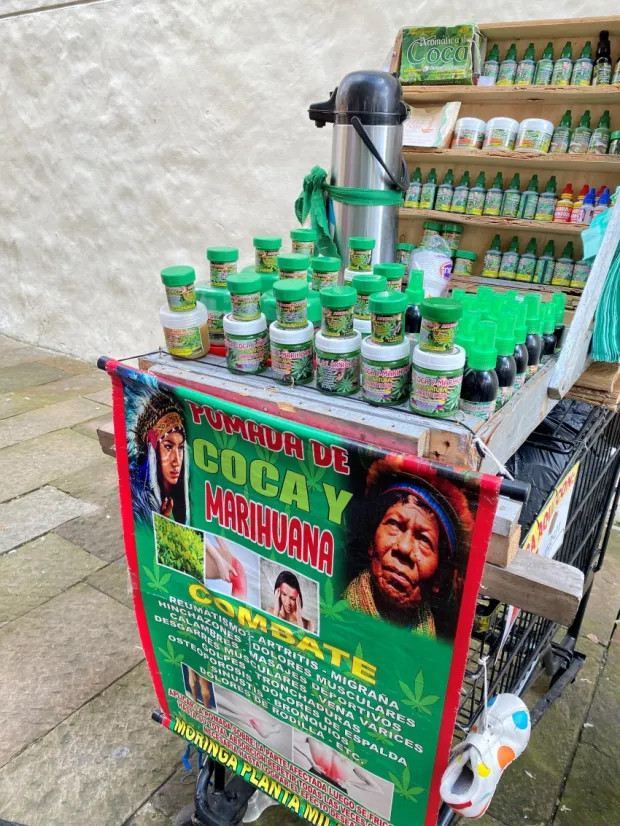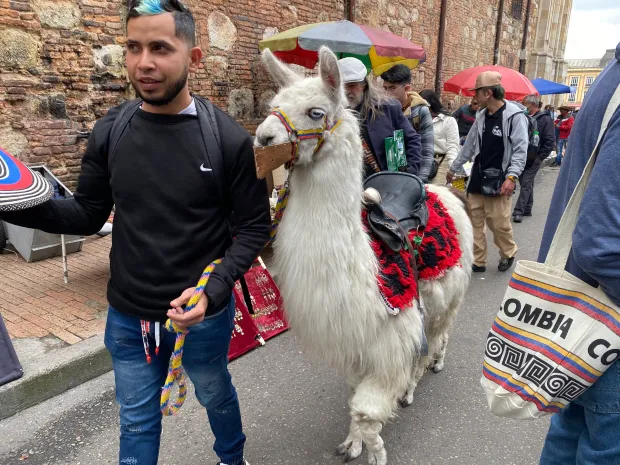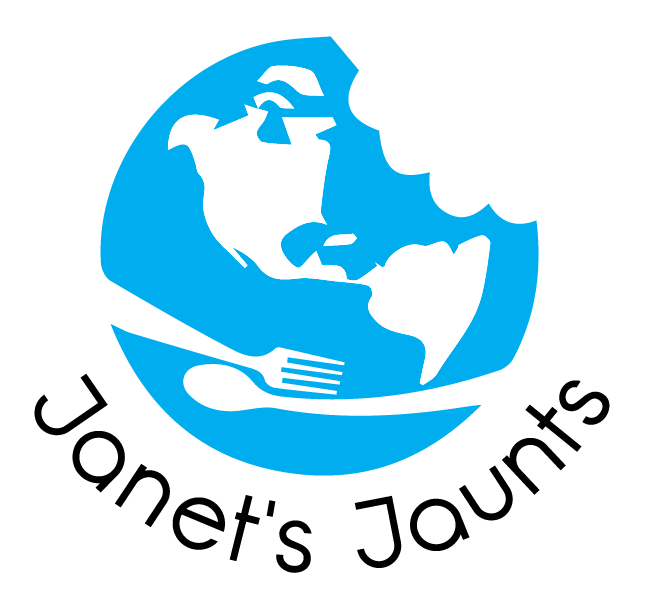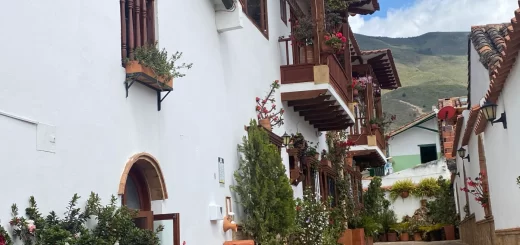Bogota, Colombia’s capital: closer, cooler and more interesting than you’d think
South American city characterized by altitude and attitude

A worker carrying a load follows the easier flat stones in the middle of a cobbled street in the Candelaria neighborhood, near where Bogota was founded in 1538 by Spanish conquistadors. Graffiti from street artists fills the walls. (Janet Podolak)
Breathless at the start of my visit to Bogota for a conference last month, I quickly learned that was because of the Colombian capital’s 8,800-foot altitude high in South America’s Andes.
Its altitude keeps things cool in Bogota, despite Colombia being just 5 degrees north of the equator. It was 52 degrees and rainy on the day I arrived.
I did as the natives do for altitude issues and purchased coca tea, made from the green leaves of the same plant used to produce cocaine. Coca tea is widely served by street vendors and in restaurants, bars and hotels, although the leaves are usually chewed by locals and indigenous people. It helped alleviate my breathless, head-achy reaction to the higher altitude. The plant, long considered sacred among indigenous people of Colombia and Peru, is commonly made into tea and is completely legal. Not only is it used to combat altitude sickness, it’s also used as an anesthetic.
The plant, long considered sacred among indigenous people of Colombia and Peru, is commonly made into tea and is completely legal. Not only is it used to combat altitude sickness, it’s also used as an anesthetic.
Acres of the leaves, grown on huge plantations, are needed for processing into cocaine. In the years before drug king Pablo Escobar’s death, Colombia was considered the world’s cocaine capital, sending tons of the drug to the United States and other countries and prompting wars among competing drug cartels and government corruption that claimed an estimated 200,000 lives in a 30-year time frame.
Colombia’s progressive new president has begun efforts to decriminalize cocaine in the belief the move will permit more oversight and government regulation of the cocaine industry. Colombians already are permitted to possess small amounts of cocaine and marijuana for personal use.
The decriminalization effort is similar to the city government’s reaction that resulted in the popularization of Bogota’s amazing street art. Graffiti had been illegal and punishable by jail time until 2013, when musician Justin Bieber, in Bogota for a concert, decided he wanted to leave his graffiti signature near a bridge underpass in the city. Escorted by officials and with their permission, the celebrity drew a Canadian flag as a marijuana leaf instead of its maple leaf. The outraged reaction by street artists drew hundreds to picket and produce more than 700 graffiti images on walls and buildings. Soon after that, the laws were changed, and many neighborhoods became covered in the artful graffiti for which the city has become known. The easily walkable Candelaria neighborhood, where Bogota was founded in 1538 by Spanish conquistadors, is the heart of the graffiti district. The street art depicts much about the way of life in this South American country twice the size of Texas.
Soon after that, the laws were changed, and many neighborhoods became covered in the artful graffiti for which the city has become known. The easily walkable Candelaria neighborhood, where Bogota was founded in 1538 by Spanish conquistadors, is the heart of the graffiti district. The street art depicts much about the way of life in this South American country twice the size of Texas.
I began my visit to Colombia with a four-day trip into the Andes to Boyaca, north of Bogota, where my small group would experience native ways of cooking, hat-making and creation of ceramics.
Six of us traveled by four-wheel drive through hairpin turns, up narrow, often unpaved, roads into the Andes countryside at 10,000 feet, visiting small villages and midsize towns. Despite the altitude, flowers surrounded us, growing in wild abundance to cover the landscapes. Colombia, we learned, has more than 50,000 species of orchids and other flowers and is one of the world’s largest exporters of roses and carnations. Puffy clouds sometimes enveloped us, lending their moisture to everything. Even though the precipitation was more like mist than rain, our raincoats were a must. It was a surprise to see the moisture encouraged the growth of Spanish moss on trees even this high in the Andes.
Puffy clouds sometimes enveloped us, lending their moisture to everything. Even though the precipitation was more like mist than rain, our raincoats were a must. It was a surprise to see the moisture encouraged the growth of Spanish moss on trees even this high in the Andes.
We learned the country has 314 ecosystems in its six natural regions: Andean, Pacific, Caribbean, Orinoquía, Amazon and Insular, with almost 2,000 species of birds. More than 300 beaches line more than 1,000 miles of coastline on both the Caribbean Sea and the Pacific Ocean.
Later, on a visit to the Bogota market Mercado La Perseverancia, we learned that hundreds of kinds of fruit are part of the Colombian diet, served as an ingredient, sliced and as a variety of juices. We found a mind-boggling array on the breakfast buffet at our Hilton Hotel Corferias in the city’s business district.
Although corn, plantains, 127 types of potatoes, beans and rice are diet mainstays, available dishes also include dozens of cheeses. Insects, such as crunchy, smoky-tasting morsels called Fat Ass Ants, are sold on the streets and eaten like popcorn. They’re reputed to be aphrodisiacs, but I can’t attest to that because I only ate one. Coffee is served in tasting bars, where those from different regions can be sampled and paired with foods. Remember Juan Valdez? His name is now used for a widespread chain of coffee shops not unlike Starbucks in this country.
Coffee is served in tasting bars, where those from different regions can be sampled and paired with foods. Remember Juan Valdez? His name is now used for a widespread chain of coffee shops not unlike Starbucks in this country.
Colombia’s 49 ethnic groups include those that inspired the search for gold throughout South America in the 1500s by the Spanish Conquistadors. Gold, believed the earth’s manifestation of the sun, was part of the worship and personal ornamentation for the ancient Muisca people, who also believed it must be returned to the earth as their sacrifice. Their chief would cover himself with gold and take golden offerings to dump in the middle of Guatavita Lake, inspiring the legend of El Dorado among Colombia’s Spanish conquerors. Many pre-Columbian ornaments, recovered from the lake, are displayed at the city’s outstanding Gold Museum, which expertly portrays the roles of its original tribal people in the history of Colombia.
Although it has rainy and dry seasons, Bogota’s climate is the same year-round, with highs around 60 and nights in the 40s. Colombians in more tropical regions of the country call Bogota “the refrigerator.”
Get more information at colombia.travel.
Look for a story in November about a visit to the artisan villages of Boyaca in the Andes north of Bogota, where hands-on experiences using native techniques of cooking, hat making and ceramics will be explored.


Recent Comments